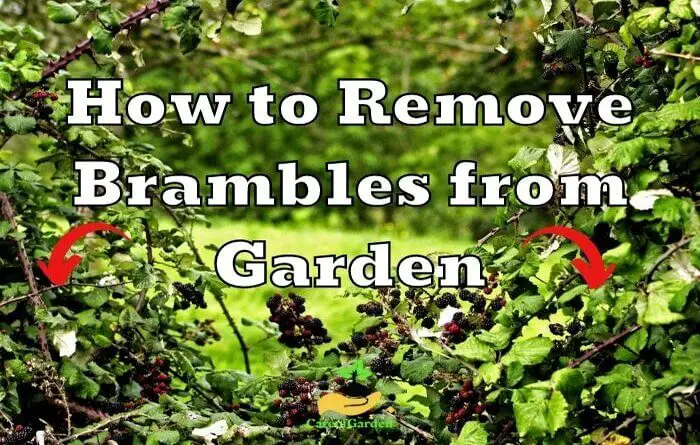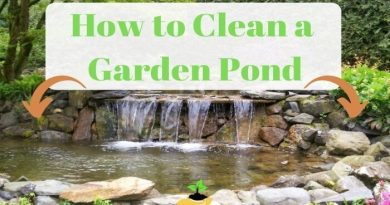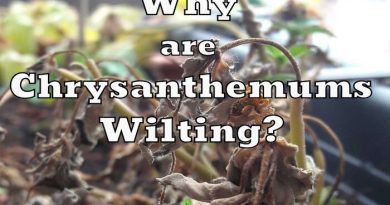How to Remove Brambles from Garden [3 Proven Methods]
Is your garden overgrown with brambles? Are you looking for an effective solution how to remove brambles from garden?
One of the big problems when it comes to removing brambles from your garden is the fact that they are perennial plants. This means that they will grow back every year unless they are completely killed and removed, which requires a bit of effort if the bush is already well established. The question then is how to get rid of brambles from garden completely.
Owning a garden essentially means taking care of the soil throughout the year, in order to eliminate weeds that can take root and grow exponentially, suffocating all kinds of cultivation. The seeds, carried by the wind during the spring, are deposited on any type of soil and sprout periodically depending on the species to which they belong.
Some of these grow and die over a few seasons, producing seeds that will spread around the surrounding areas by multiplying the shoots. Others, on the other hand, survive the cold and hot periods, thanks to the roots that act as a reserve and allow the weeds to grow. Brambles are undoubtedly the worst plants, and eliminating them is not easy.
Below we will give some tips on how to remove brambles from garden. Let’s see how to proceed to carry out an intervention worthy of the most experienced gardener!
| Methods: | How o Remove Brambles from Garden |
| 1. Chemical Removal | Herbicides: Glyphosate and Triclopyr |
| 2. Natural Remedy | Water, Vinegar and Salt |
| 3. Manual Removal | Brush Cutter Hedge Trimmer Using Hoe Tool Rotary Tiller Burning |
1. Remove Brambles from Garden with Chemical Remedy
A timely action that stops the growth of brambles weeds is often the simplest solution to avoid finding yourself with tall grass in early spring. One of the most common chemical herbicides is glyphosate, which acts on a systemic level within the plant where it is spread through the lymphatics.
In this way the chemical component enters the roots, activating their gradual drying up and leading the weeds to death
You will need the following:
- glyphosate or triclopyr herbicide
- cutting tools
- gloves
1.1 Glyphosate
The treatment for remove brambles from garden should be done when the young plants are beautifully luxuriant, so that they absorb the herbicide well and there are no other plants in the soil.
The treatment with glyphosate must be done constantly at least 2-3 times if you want to be sure of the total drying of the roots of the brambles, which usually takes place within a maximum of 7 days. The herbicide should usually be administered early in the morning, on non-windy days and suitably diluted in water according to the recommended doses on the manufacturer’s packaging.
The quantity to be dissolved in water is indicated on the packaging. Usually, however, it does not exceed 200 ml per 10 liters of water.
It is recommended to use the herbicide twice a year, as follows: the first in winter when the bramble plants enter into vegetative rest and the second in early spring period, when the plants resume their vegetative cycle and begin to emit the new shoots that later become robust and full of thorns.
Glyphosate herbicides are very effective and inexpensive. They kill the root and stem of a bush in no time. The problem is that you have to be very careful that it does not fall on grass areas or other plants if we do not want to kill them as well.
1.2 Triclopyr
Triclopyr is another chemical remedy used to remove brambles just as effective as glyphosate and can be applied to grass without killing it. So, if you are worried that your lawn could suffer, use this one better.
Both herbicides are systemic. This means that the plant absorbs them and reaches the roots. That is why they are so effective. The whole plant dies and will not be able to grow the following year.
The best thing is that before using it, you clear the branches of the bramble, leaving the plant between 15 and 20 centimeters high.
If you are going to want to sow that field with grass later, use better glyphosate, because it becomes inactive once it touches the ground. It will be safe to plant grass later.
2. Remove Brambles from Garden with Natural Remedy
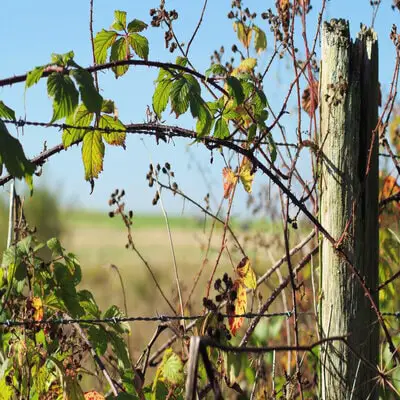
Among the solutions that respect the environment, agricultural land, pollinating insects and also active on these types of weeds, a very effective and economical method is a solution of water, vinegar and salt that is prepared when needed.
Ingredients and doses needed to remove the brambles from garden are:
- 1 liter of water
- 250 ml of white vinegar
- 100 grams of salt
Pour the ingredients into a large enough container and then mix until all the salt dissolves. To facilitate the dissolution of the salt, it is advisable to use hot water.
Finally, add the vinegar, an organic acid that is effective on any type of weed.
Stir again until a homogeneous solution is obtained. After this the ecological herbicide solution is ready for use.
Pour it into a diffuser and sprinkle the foliage of the brambles and the lower stems hugging the ground.
The results will be visible from the first week of the treatment. The first to dry are the most common herbaceous plants of the parietal type. To enhance the action of the herbicide, the treated plants can be suffocated with straw mulch.
Another natural solution involves adding lemon, alcohol and dish soap to the previous mixture and should be used if the brambles have more stronger stems. The effectiveness of this mixed solution for brambles is visible already after the first week of treatment.
Remove brambles with a natural herbicide
You will need the following:
- vinegar (3 liters)
- salt (1 kilogram)
- a small amount of dishwasher detergent
- a retained pressure sprayer
Many people do not like to use synthetic herbicides in their garden because of the damage it can cause to other plants and the risk they pose to children and animals. So in that case, the only option is to make your own natural herbicide.
Combine the ingredients and let them rest for about five minutes. Once it’s ready, add the mixture to the pressure hold sprayer. Spray the bush scrub and soil around the base of the plant.
Keep in mind that this only works with small plants. Bramble bushes have extensive roots and it is very difficult to attack them well with such a herbicide.
If we are talking about a small plant, wait for the compound to take effect for a few days and then dig up the dead plant.
3. Remove Brambles from Garden Manually
Eliminating brambles is necessary when the plant, with its long shoots, invades the ground, hindering the growth of fruit trees or horticultural plants. There is a period of the year when it is convenient to clean the ground from brambles and it is autumn-winter.
During this long season, the bramble plants are in vegetative rest and lose part of their foliage, which renews itself, since it is a semi-deciduous species.
Manually removing all the brambles is a long operation and can be difficult, especially if the brambles are well rooted in the ground. However, also to facilitate the absorption of the herbicide in the plant, it may be useful to manually remove at least the upper part of the plants.
3.1 Brush Cutter
The most used equipment to remove brambles from garden is the petrol brush cutter. This tool is essential in inaccessible places, on slopes, where the space available to move is limited.
Not all brush cutters can be used to cut brambles. In fact, the strength and power of the tool are fundamental. Therefore, for example, battery-powered brush cutters with light shafts, which are usually used to cut grass in the garden, are not recommended.
The recommended power is from 35 cc upwards. Backpack brush cutters are much more comfortable to work, even for a long time, but obviously they have higher costs.
The blade suitable for cutting brambles:
The blade is the necessary accessory, capable of cutting even woody stems of a certain diameter. Among the various commercially available brushcutter blades, some are more effective than others for shredding brambles. The best ones are those that have two or more folded wings, as they are able to literally grind the branches of the bramble at the slightest contact.
A trick for cutting brambles with a brush cutter is to work the thick bush vertically and not horizontally as we usually do with grass.
The shaft of the brush cutter should work from top to bottom, trying to progressively lower the bush, until it reaches the ground. In this way, unpleasant tangles are avoided. In addition, the work is faster and more orderly, as there is no need to go over the tool to shred the branches of the bramble.
3.2 Hedge Trimmer
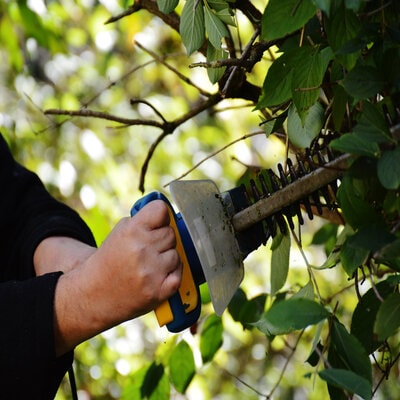
The petrol brush cutter is not the only tool that we can use to remove brambles from garden. In particular conditions, and with an adequate technique, in fact, it is easier to use the hedge trimmer. The conditions are level ground and the ability to move freely in space.
In addition, the work with the hedge trimmer is done in two. There is the operator with the tool that “slices” an internal section of the bush and the other person who pulls the “slice” of bramble cut outwards with a pitchfork, in order to facilitate further entry of the hedge trimmer into the blanket.
The square of thorn brambles is then cut from below, rolled up with a fork or billhook and moved like a huge bush. In practice, with the hedge trimmer you avoid shredding the bush, but you slice it in a geometric way, with a huge saving of time and effort.
3.3 Hoe and Rotary Tiller

One of the best known and most common methods to remove brambles from garden is to act on the roots, uprooting them. You will have to arm yourself with a lot of patience, a hoe and a rotary tiller and weed out the roots of the brambles. You will have to carry out manual weeding carefully and, with a lot of patience and willpower, you will be succeeded to clean your garden.
Manual trimming of brambles is the first method of choice for getting rid of brambles. Equip yourself with a pruning shears and a suitable pair of gloves. Locate the bramble stump in your hedges and cut all the shoots flush. Then remove these shoots by hand. On a regular basis, check for new growth and intervene early enough to get rid of them more easily.
3.4 Burning
Another well known but not very recommended method is to burn brambles. If you decide to use this method you will have to do it very carefully, as the fire could be a danger to yourself and your garden.
You will have to use it only if the weeds are concentrated in a small area, away from other plants, and with the help of a water pump always at your side. When you put out your bonfire you will still have to pull out the weeds with the help of a hoe tool.
How to Protect when You remove Brambles from Garden
Before starting to clean the garden of thorns, it is always recommended to use protective equipment.
The roots are covered with thorns, and you risk a serious cut if you do not do this work with protective equipment. It is advisable to cover all exposed skin with long sleeves and pants. Wear high quality goggles and work gloves.
Do not use rubber or light gloves, as the thorns will pass through them. Also, if you suffer from allergies or asthma, cover your face with a dust mask. Removing thorns generates a lot of allergens that could irritate the airways.
General tips: How to Prevent brambles From growing In your Garden?
Preventing brambles from growing in your garden is, outright, the best way to save yourself a ton of effort later. What happens is that there is no way to do it that guarantees total success in this endeavor.
- The best method to do this is to remove them when they are no more than a small bush. This process is much easier than removing them later when they are a fully grown shrub.
- Make sure to keep an eye on your garden from time to time in case any show up and take action as soon as possible.
- Keep the grass cut regularly. The best way, if your budget allows it, is to buy a robotic lawnmower or autonomous lawnmower.
- If you have any areas especially susceptible to brambles (for example, near a lazier neighbor’s garden) try spreading some mulching material. This makes it easier to remove the small bramble bushes later when they appear.
Conclusion
Finally, brambles suffer from competition with other crops. So, when you clean a garden from a bush it is better to put it immediately in cultivation, with vegetables or fruit trees. Among other things, the soil that we will have available will be very fertile, as it is preserved by the presence of the weed itself.
The brambles weeds reproduce very easily to invade a garden. In this article we presented out effective methods and our tips for removing brambles from your garden. Choose the methods that is easy for you!
FAQ
How to identify brambles?
Brambles can be recognized by their sometimes fierce thorns, which cover the entire length of the stem. The leaves, cut into 3 to 5 leaflets, also bear thorns. Depending on the season, brambles can also be identified by their flowers, or the presence of blackberries.
When to remove brambles weeds?
The end of autumn and winter are the best periods for cleaning : the garden is at rest and hardly requires any maintenance, freeing up time to start clearing an area of brambles .
Bramble, like most plants, is also in a dormant period. Its development is stopped while waiting for the return of fine weather and its blooming awakening around May.
Brushing the bramble at this season also helps prepare the garden for future spring plantings, whether they are in a vegetable patch or as an ornament.

